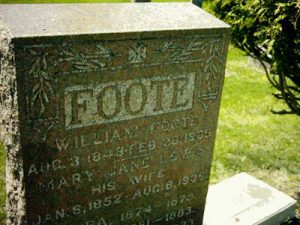William Foote
Foote, 58 years Fireman – St. Thomas Times Journal – 26-Feb-1935
For 58 years a member of the St. Thomas Fire Department, and a member of the Fenian Raids, William Foote died at 86 yrs old.
Born in St. Thomas, Mr. Foote spent his entire life here, seeing the place to city hood from the tiny village in which he was born, then centered in the Kettle Creek Valley at the foot of Talbot street hill. Only one short period of his life was spent away from St. Thomas; for eighteen days he served as a member of the St. Thomas Cavalry and was sent to Windsor during the Fenian Uprising. Beyond that short period, his entire life was spent here, where he faithfully employed his time as a member of all the fire departments the city ever had.
Mr. Foote attended a little school at the foot of the hill on the Fingal Road just a little beyond where the M.C.R. bridge now crosses Kettle Creek and of which there is no written record. He later attended Central School, which grew from a four-roomed structure to the building which is now Wellington Street School.
Mr. Foote married Mary Jane Lewis and had two sons – George E. Foote and Lewis Foote.
In 1873, he joined the Beaver Fire Department when it included such well known old-timers as Fred Doggett, William Walbourn, Sam Bowlby and Fire Chief “Sandy” Henderson. He automatically became a member of the city fire department when the municipality undertook to establish and maintain its own department. He was the first paid member of this department.
Fires Came First
Recalling the early days on the department, Mr Foote was cited as saying that one of the duties of the department members was to sweep the streets, and if a fire alarm came in, the broom job had to be chucked on the spot and a mad dash made for the fire station. Out came the hand-drawn pump which had to be pulled along the streets to the scene of the fire where it took “sixty men” to work the pump.
Life in the employ of the city’s early fire department bound its members “hand and foot” to the job. One of the requirements was that the members “live” in the fire hall. If any of the members chose to marry they had to suffer the consequences for no wives were allowed to live at the station. Mr. and Mrs. Foote were married for thirty years before they lived together. Only at meal times did Mr. Foote spend time at his home. It was not until the city employed an all-paid fire department that the couple were able to enjoy a proper home life.
Describing his early experiences, Mr. Foote said: “We were on duty 24 hours a day, on at 10 o’clock at night to sweep the streets until five or six in the morning, and after that on watch at the fire hall all day. I only went home to meals. In the first ten years I never had a day off, not even a Sunday. After that we got one Sunday off in three, then later, one day a week. Until the time came when we got one day off each week, we never had a chance to go to a ball game or any sort of recreation or entertainment. Not only in theory, but in fact, we were on duty every hour of the day, year in and year out. And the pay was $37.50 a month.”
Mr. Foote would add that there was one compensation for this rigorous routine. He was always sure of his pay at a time when “men worked for employers who were not reliable paymasters.”
